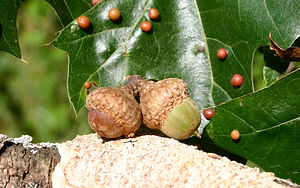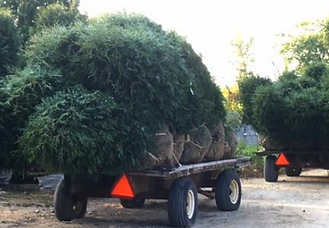

NATIVE TREES • CANOPY & UNDERSTORY ORNAMENTALS • EVERGREENS • SHRUBS
McHenry County Nursery
WHOLESALE
Growing
Plants with Purpose
TM
PROPAGATION
We are learning every year. Propagation has become a central part of the operation as we strive to improve our production and growing methods by starting out with the right plants.
We propagate by seed, softwood cuttings, or root cuttings. The strongest cuttings and seedlings are selected to develop into liners that are grown for several years as we strive for a healthy top and a well-branched root system.


GROWING
Our field soils laid down by the glaciers and forests of tens of thousands of years ago contain many physical and chemical soil characteristics perfect for growing trees. The soils on our moraine slopes are prone to erosion, so we have aerial contoured all our farms with permanent grass strips between the tree rows. The grass greatly reduces compaction around the root zones.
The trees are kept clean cultivated up to three feet from the trunks, reducing competition and creating an area where rain soaks in where it is needed and fertilizer and topsoil stay in place. We mow the grass strips depositing the grass into the cultivated areas adding organic matter to the soil.
The goal of our fertilizing program is to increase health of the tree - not to over-stimulate top growth. The purpose of fertilizing is not to get a big tree fast, but to improve the appearance and condition of plants, and increase vigor to make plants more resistant to stresses.
Our trees and shrubs are monitored for diseases and pests and treated in the least toxic manner. Plants that are too pampered in their growing site will require pampering in the landscape.

HARVESTING
Our specimen B&B trees are dug by skilled crews at the optimum time of year, with the right root-ball size based on the above ground portion of the plant. Even though the majority of the root area is removed, the majority of weight and stored food is in the harvested roots, which easily regenerate new roots. Since we plant every tree by hand in our clay-loam soils we can certify that our trees are planted at the correct depth. Also, we remove any excess soil at the time of digging and use four-bladed truncated tree spades which give the maximum root mass for the caliper inch.

PLANTING FOR THE FUTURE
The majority of our plants are propagated by seed, softwood cuttings, or root cuttings. The strongest cuttings and seedlings are selected to develop into liners that are grown for several years as we strive for a healthy top and a well-branched root system.
They are then transplanted into #3 up to #20 pots depending on the plant, and maintained in our container and pot-in-pot ranges.
Our growing areas are watered and fertigated through a drip system equipped with a drainage system connected into our terracing and waterway system to conserve water and eliminate run-off.

THE BIG TREE PICTURE
(Excerpt from Oak Recovery Project Booklet published 2015, p33)
Oaks can be challenging to grow and market. They grow more slowly than other species, require extra steps to germinate, and care is required to encourage vigorous root growth. Many nurseries are wary of growing oaks because they do not perceive demand for the trees. However, Glacier Oaks Nursery specializes in growing oaks and other native trees. They overcame the hurdles by using locally collected seed, creating quality products and collaborating with customers, communities and groups that plant and care for the trees.
We grow and transplants using methods that train and maximize fibrous root systems. Careful monitoring of soil pH and nutrient levels, along with judicious and timely pruning, promotes fibrous roots and healthy tree production. They are careful not to over water or over fertilize trees, which could inhibit the development of their natural responses to drought.
It takes around five years to grow an oak to the selling size of a two-inch caliper. Many young seedlings are donated or sold to conservation organizations and other natural areas. Other trees are sold at municipal plant sales at two to three years old. Select groups are transplanted to the field and grown to two-inch caliper and larger for municipal landscapes.
We work with conservation organizations and partners with agencies that specialize in education and community involvement to improve public awareness of the value and importance of our native oaks. This helps foster a commercial demand for the trees.
